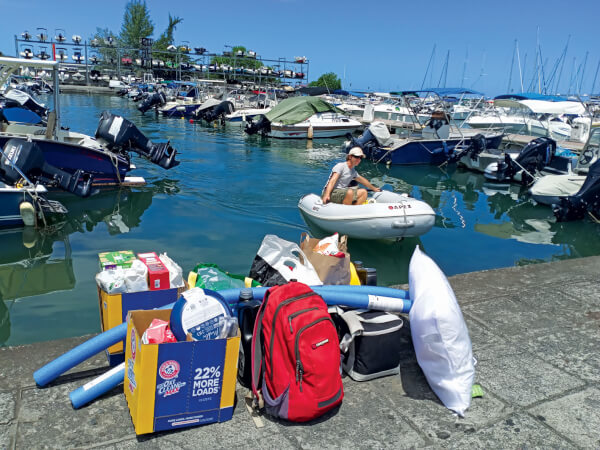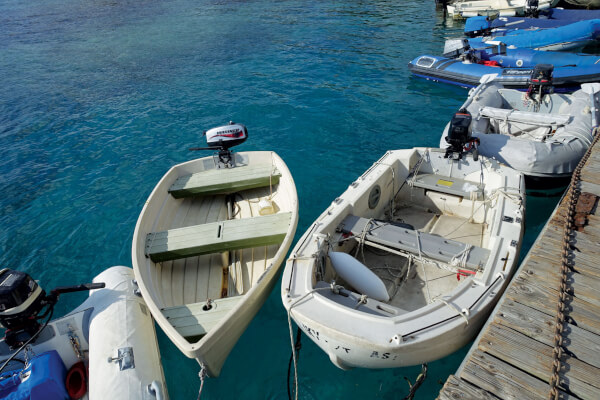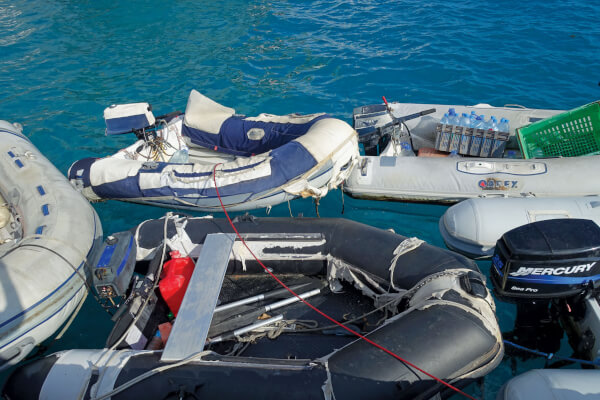Dinghies are for cruisers what cars are for landlubbers. Occasionally we take them round the anchorage just for fun or to entertain visitors on boards, skis or hydrofoils. But usually they are just a means to get ashore and to transport stuff. Every cruiser needs one, but with the amazing range of different designs on the market, it’s not easy to decide which type fits your needs and literally fits on your boat. Here’s an overview and some pros and cons to help you find a rigid or flexible partner for a happy, lasting relationship.
The Puristic Solution
Some minimalist cruisers or those with a tiny sailboat manage with just a surfboard or kayak as main means of transport ashore.
Pros: Such vessels take up little space when they are rigid, and almost no space when they are foldable or inflatable. Additionally they add some work-out to the daily routine and can even carry small shopping bags and docile dogs.
Cons: The fun factor drops in rough conditions, cold weather and whenever larger goods need to be shipped. We certainly wouldn’t risk paddling a case of beer on a wobbly kayak in rough seas…

Flexible Alternatives
Hypalon or PVC dinghies with an inflatable keel are ideal for those that have neither davits nor space to store the dinghy on deck during passages.
Pros: They come in all sizes, plane quite efficiently and (once deflated) can be rolled up to tiny bundles and stored in a corner on or below deck.
Cons: They have a certain ‘wobbly’ feel about them once you step in—unless they come with a rigid floorboard (if not it’s fairly easy to fit one into most designs). Hitting a reef underway or leaving them to chafe on a rocky shore would quickly end their lives, so caution is necessary. Collisions, chafe, material fatigue or faulty glue seams can easily result in leaks, but repairing such damages is fairly easy with the right gear and proper glue (once you’ve found the hole).

Rigid Inflatable Boats
When I first heard the term I thought it was a contradiction. What now, rigid or inflatable? Nope, both…
Pros: The most popular type of cruiser car combines the stability of a hard bottom with the safety and comfort of an inflatable dinghy. They are happy to plane fast and efficiently with a proper outboard on. Smaller designs can be semi-deflated and stored on deck during passages, bigger ones can be lifted on davits in anchorages and even on passages. Deluxe versions even come with a helm station.
Cons: Their pontoons are just as prone to leaks as those of their foldable colleagues.

Rigid Dinghies
Rigid dinghies feature different materials from wood to aluminum. They come in numerous designs and some cruisers even build theirs to perfectly fit their needs (e.g. to fit snugly on a certain spot on deck or on top of the doghouse, either in one piece or taken apart).
Pros: Their main advantage is that they are much more suitable to be rowed and hold their course better than inflatable dinghies and their semi-rigid colleagues, because they are narrower and most have a keel. Big, modern designs plane well and are perfect to transport bulky goods (like dive bottles or large dogs with sharp claws), but of course they are heavier and therefore not that easily rowed.
Cons: Small specimen feel rather unstable when you step in and may sink if overloaded in rough conditions, big ones are difficult to store.
Sailing Dinghies
Some cruisers have classic, wooden sailing dinghies, others just add a mast and sails to their rigid rowing dinghy and we’ve even seen a RIB sailing by with a folding mast (mast step glued to the floor) and daggerboards attached to the sides.
Pros: Sails are certainly the most elegant and fitting way to propel the dink of a sailboat! No fuel consumption, no noise, no pollution. Tacking up to the dinghy dock, you may arrive slightly late for happy hour, but you’ll arrive in style. An auxiliary engine deducts some of that style, but adds safety and utility to the vehicle.
Cons: Without an engine they pose a certain safety risk in changing weather conditions and they are not easy to store for passage on an average cruising boat.

Flying Dinghies
Seriously, we’ve seen one! Okay, just once, but we really witnessed a dinghy elegantly flying over our boat, with two people in it. Yes, we were just having sundowners, but no, we were not drunk (yet) and we took pics to prove it. We couldn’t see details as the combination of an ultra-light plane and a RIB flew past, but I like to imagine that the “flinghy” also had an additional mast step for a sail and wheels to land ashore. The coolest, most-versatile of all dinks. Ever.
Birgit and Christian have been cruising aboard their S&S Pitufa for 11 years. Check out their blog www.pitufa.at for more info or follow SY.Pitufa on facebook! “Sailing Towards the Horizon,” the book about their journey, is available on amazon.com





